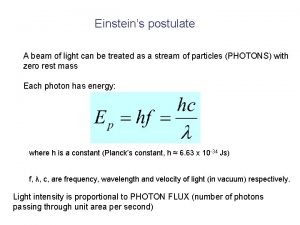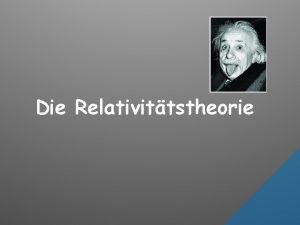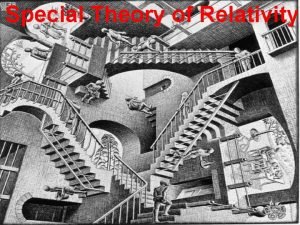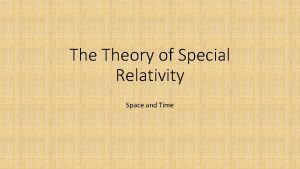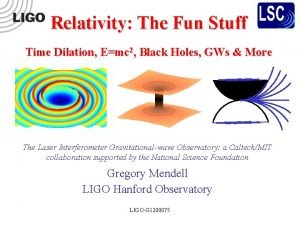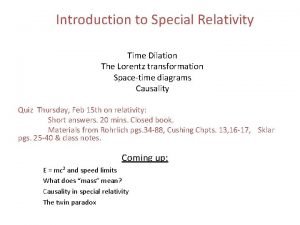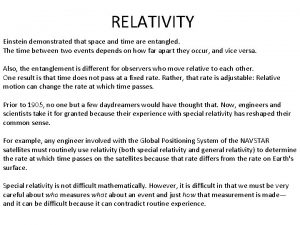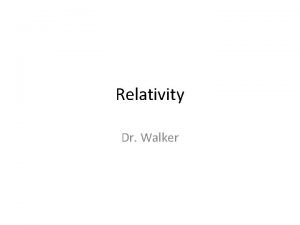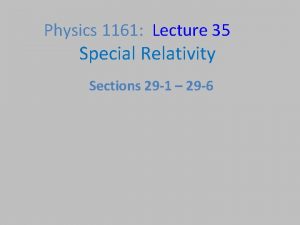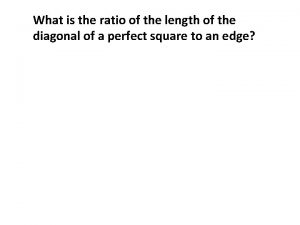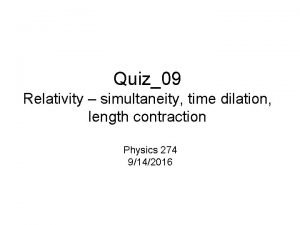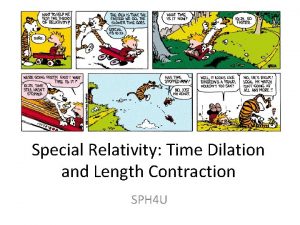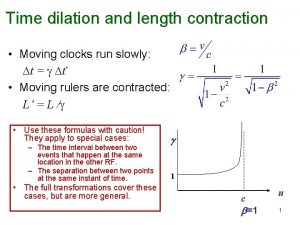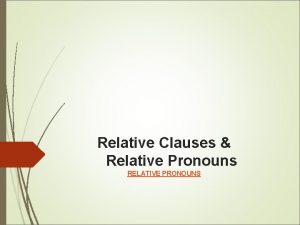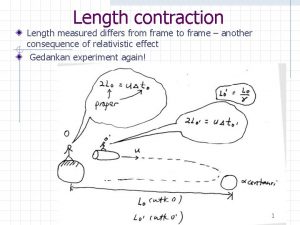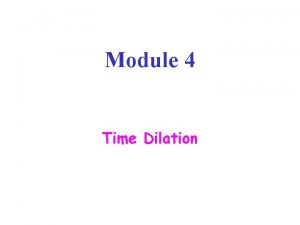Einsteins two postulates Time dilation length contraction Relative


















- Slides: 18

Einstein’s two postulates Time dilation & length contraction; Relative simultaneity the symmetry of SR Coming up: The unification of electricity and magnetism E = mc 2 F ≠ ma The locality of conservation laws

Ether effects • The ether started out as an almost meaningless hypothesis, "the stuff in which light is a wave" or "the stuff which is always at rest in the frame in which Maxwell's equations work". Now to explain experiments, we find that the ether has all sorts of effects on things moving through it – Shrinks rods – Slows clocks – Changes masses. • That sounds like a great confirmation of the ether's reality, until you notice that the net effect of all these changes together is that: The motion through the ether is undetectable!

Einstein's approach • initially motivated by Mach’s conception of a completely relationist universe. (For Mach, even acceleration was relative. ) Precursors to special relativity retained the notion of absolute space in the guise of the ether. • Why does one use one equation to describe a conductor moving past a magnet and another to describe a magnet moving past a conductor? – “It is known that Maxwell’s electrodynamics – as usually understood at the present time – when applied to moving bodies, leads to asymmetries which do not appear to be inherent in the phenomena. ” Einstein, “On the Electrodynamics of Moving Bodies, Annalen der Physik, 17 (1905). • Einstein: – "The phenomena of electrodynamics as well as of mechanics possess no properties corresponding to the idea of absolute rest. The same laws. . . will be valid for all frames of reference. " • That postulate (relativity) sounds familiar, but how can we combine it with Maxwell's equations?

Einstein’s two Postulates 1. “If, relative to K, K’ is a uniformly moving coordinate system devoid of rotation, then natural phenomena run their course with respect to K’ according to the same general laws as with respect to K. This statement is called the principle of relativity (in the restricted sense). ” Einstein, Relativity, p. 16. • applies to all phenomena (including electrical and optical), not merely mechanical. So, what to do about Maxwell’s equations? We accept them: 2. “. . . experience in this domain leads conclusively to a theory of electromagnetic phenomena, of which the law of constancy of the velocity of light in vacuo is a necessary consequence. ” The insistence that these two "apparently incompatible" principles are consistent is the new idea. Let's see more carefully why these two ideas seem inconsistent- the worst thing you can do is to simply accept them without drawing the necessary consequences.

Implications Let's say speed of light = c in ALL inertial reference frames. A and B are inertial observers, C is a blip of light. Just for convenience, let them all start out at the same spot at t=0. A d. AB B d. AC d. BC C (d. AB here means the distance to B measured from A by A) What do we think we know? • Therefore our two postulates cannot both be true unless something is drastically wrong with our basic ideas about space and/or time! • If you think you can just accept both postulates as reasonable, you haven't got it. – Possible changes:

Do Perpendicular Lengths Change? • The Michelson-Morley result implied that the ratio of the length along the motion to the length at right angles to it shrank by a factor of SQRT(1 -v 2/c 2) • We now argue that lengths perpendicular to the motion remain unchanged. Moving observers agree about the dimensions of objects along directions transverse to the relative motion. – Can you figure out why? If the moving rod either shrinks or grows, that determines which rod leaves scratches on the inside of the other. But by symmetry, it has to go the other way as well. Anybody can come by at any later time and see who actually got scratched. So it's an objective feature, and everybody has to agree how it came out. By symmetry, the two lengths must then be the same in either frame. A B A OR Notice that the argument implicitly assumes that some features of the observed world must be invariant. B

Time Dilation • We immediately derive that two observers (moving w. r. t. each other) cannot agree about time intervals. • First, define “clock”: an object which repeats a process many times. A simple clock might be a pair of mirrors with a pulse of light bouncing back and forth. Three “snapshots”: Consider what happens when two identical clocks are moving w. r. t each other. Look at the path the light travels: K says that the moving clock ticks slowly by a factor of 1/ (1 -v 2/c 2)1/2 , because the light travels farther between bounces, while still moving at speed c.

Who has the right time? • The principle of relativity tells us that K’ (the person who owns the "moving" clock) will reverse the roles of the two clocks. K’ will say that the clock owned by K is moving and ticking slowly. • There is no non-arbitrary way to answer the question, “Who is right? ” (Here, there's not even agreement about who's running faster, much less about who's right. ) As a consequence: – There is no absolute time. • The size of the effect is the same as Lorentz’ time dilation, but it is conceptually different. For Lorentz there was a preferred frame (the ether), and all clocks moving through the ether ran slowly with respect to absolute time. Now there is no preferred frame. Each person says that clocks moving wrt him are running slowly. • Just to be sure you understand. . . – The reason K and K’ disagree about the clocks is that although they see the light taking different paths, they both say the light is travelling at c relative to themselves. It is NOT a matter of them being too stupid to correct for the travel time of the light- their corrections disagree because they disagree about the relative speed of the light wrt to different objects.

Simultaneity (see Einstein, ch 9) • Suppose a train is moving past Fred, who is standing on the embankment. Barney is riding in the middle of the train. Two lightning strokes hit the ends of the train at times such that Barney sees the two flashes at the same time. At that instant, he is passing by Fred (i. e. , they are at the same place when they see the flashes). • • The question is, “Were the two lightning strokes simultaneous? ” Barney says: – The lightning hit the two ends of the train, which are the same distance from me. Since I saw the two flashes at the same time, the two strokes must have occurred at the same time, namely L/c before I saw the flashes. • Fred says: – When the lightning struck (some time in the past) the front of the train was closer to me than it is now, and the rear was farther. Thus the two flashes traveled different distances. Since I am seeing them at the same time, they must not have been simultaneous. The one at the rear happened first.

Who is right? • There is no way to tell who is right, so: – Simultaneity of distant events depends on the motion of the observer. • Like time dilation, this results from the invariance of the speed of light. It depends on Fred and Barney both seeing light from flashes moving at c, even though they are moving w. r. t. each other. – It is impossible to prove that the light moves the same speed in both directions. That is an assumption, based on the apparent isotropy of space, and the simplicity of Maxwell's equations. It is not important in this situation, because if we assume that the speed of light is different just exactly to cancel the effect, it will double the effect when the train moves to the left. – We could consider a different pair of strokes, which Fred says are simultaneous. (They wouldn’t be at the ends of the moving train. ) Barney will say that they aren’t simultaneous.

What’s Relative? • Being at the same place (at different times) is also relative. This was known by Galileo. Think about the meal you eat while travelling on a boat. – Notice: we assumed that simultaneity at the same place was objective. If Fred was at the same place as Barney at the time one light flash reached, and Barney says they reached simultaneously, Fred was also there when the other flash hit. • Important note: Once again relativity is NOT a trivial reminder that "it takes a while to see things because light has a finite speed. " Romer knew that, and it led to no changes in anyone's picture of space-time. If relativity seems obvious to you, you have not yet got it. • Relativity is a description of the symmetry of space-time. If the "c" that appeared in the equations didn't correspond to the speed of something we use to view events, or even to the speed of anything at all, the structure of theory would not change at all. It would just be harder to make up little stories to illustrate theory. – (We'll soon see the equations in full form. )

Lorentz transformation Remember how Galileo related space and time measurements made by moving observers (motion is along the x direction): Galileo-Newton Lorentz-Einstein Time intervals are the same for all observers g is the time dilation factor: Time is no longer an absolute (invariant) quantity. Notice that distances (y, z) perpendicular to the relative motion of the two coordinate frames are unchanged, as we showed was necessary. The equations look somewhat simpler and more symmetrical if we use ct instead of t and define b = v/c:

Symmetry Groups • Both types of transformation are invertible: if you transform to a primed frame using relative velocity v, then transform using relative velocity -v, you get back the original coordinates. That's obvious for Galilean transforms, and you can easily check it for Lorentz transforms. That's one of the properties that make the transforms part of what's called a group of symmetries. Since you use the same type of transform either way, you can't get a clue as to which frame is the "proper" one. • Important note again: even if there were no such thing as light, or anything else that traveled at speed c relative to other stuff, all of the essential points of relativity are contained in the new rules for converting between coordinate systems. Our arguments about "what would observer A see by using light" are not essential, just convenient paths toward these transformations. The key point is NOT about practical limitations on observations, but rather what sets of variables different observers have to use to get nature to obey the same simple laws. – I've said it thrice!

The symmetry of special relativity • Special Relativity is a symmetry of the laws of physics. It says that if you look at some set of events from any one of a collection of different reference frames in constant relative motion, the laws needed to describe the events don't change. Galilean relativity said the same thing. – But Maxwell's laws didn't obey Galilean relativity. – because G's relativity made assumptions about how some particular quantities (distance, time, mass…) changed between different frames (i. e. that they didn't change) , and those assumptions turned out to be wrong. • In Special Relativity – Moving clocks run slowly, but each person thinks his clock is at rest. – Moving rulers are Lorentz contracted along the direction of motion, but each person thinks his ruler is at rest. – Another invariant feature is whether or not two objects are at the same place at the same time. Can you think of an argument why you would expect that to be invariant?

Are there any “real” effects in all this? • Consider cosmic ray muons, which are produced in the upper atmosphere, 25 -50 km above the ground. These particles only live about 2 microseconds, in which time they can only travel a few hundred meters at the speed of light. Nevertheless, a large number of them make it to the ground. How is this possible? • The solution is time dilation. When we say that muons live for 2 µs, we mean as measured when the muon is at rest. A moving muon suffers (from our point of view) time dilation. Its clock runs slowly, and it lives longer. Time dilation factors of 100 are not uncommon in cosmic rays, so many muons survive the trip to the surface. • In order for SR to be self consistent all clocks must be affected the same way. Thus, time dilation is not a property of any specific mechanism, but of time itself. • What does the muon see?

Muon’s View • From its point of view, there is no time dilation, but the atmosphere (which is moving) is Lorentz contracted. In the 2 µs muon lifetime, the earth, traveling close to c, has time to collide with the muon because it starts close by. Both observers agree the muon will reach the surface. • They disagree about why this is so, i. e. they disagree about the values of some particular quantities used in the calculation leading to the agreed conclusion about whether the event occurs. • This is just one example from a huge number of applications. You can't even build a good electron microscope if you ignore relativity.

There is a speed limit • • • Galileo says velocities add like vectors: if – I measure you to have velocity v 1, and – You measure an object to have velocity v'2, then – I will measure the object to have velocity v 2 = v 1 + v'2. This can’t be correct in special relativity, because everyone gets the same speed, c, for light. There is a general law of combination of velocities. (derivable from the L. T. ) Let's abbreviate: b=v/c. . ) As above: – Check: if b 2' = 1, then b 2 = 1. So if something is moving at the speed of light according to one person, it will be moving at that same speed according to all observers. Example: – You measure a proton speed 0. 75 c. I say you are moving 0. 75 c in the same direction. I will not measure 1. 5 c for the proton’s speed, but rather 0. 96 c. – For small velocities (b 1 « 1 and b 2 « 1) this reduces to Galileo’s expression, because b 1 b 2' is extremely small and can be ignored. This is an example of the correspondence principle; a new theory must agree with the old one in the old one’s region of validity. You might ask, “What happens if I keep pushing on the proton? Won’t it keep accelerating indefinitely? ” We’ll address this soon.

The locality of conservation laws • We have seen various conserved quantities such as energy, momentum and electric charge. Their conservation laws remain valid (in new form) in special relativity. SR makes these laws even more strict than they were before. • Consider a hypothetical process with conserved quantity, Q: • it possible in a short time interval (dx/dt > c) for some Q to be transferred a long distance from box 1 to box 2? – We want to conserve Q: Q 1+Q 2 = Q’ 1+Q’ 2. • Newton’s physics does not forbid such a process, but SR does. This follows from the relativity of simultaneity. Suppose that I see the transfer happen at a particular time. An observer moving w. r. t. me will say that the Q changes at the two boxes at two different times. So he says there is a time interval during which Q was not conserved. This violates the principle of relativity – both observers must obtain the same laws. • Thus, conservation laws only work if they are local. Q cannot hop around. It must move continuously from one place to another, no faster than c. – We'll see why that limit later.
 Einsteins postulate
Einsteins postulate Relative geschwindigkeitsaddition
Relative geschwindigkeitsaddition Muscle
Muscle Relativistic mass
Relativistic mass Length contraction formula
Length contraction formula Theory of relativity
Theory of relativity Gravitational time dilation
Gravitational time dilation Time dilation equation
Time dilation equation Interstellar
Interstellar Law of relitivity
Law of relitivity Time dilation
Time dilation Time dilation
Time dilation Spacetime walker
Spacetime walker Time dilation
Time dilation Lead time bias vs length time bias
Lead time bias vs length time bias Length bias vs lead time bias
Length bias vs lead time bias Lead time bias vs length time bias
Lead time bias vs length time bias What is the ratio of the length of to the length of ?
What is the ratio of the length of to the length of ? Stage 15 relative clauses and relative pronouns
Stage 15 relative clauses and relative pronouns
